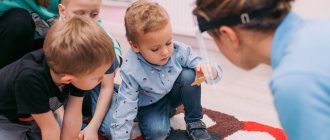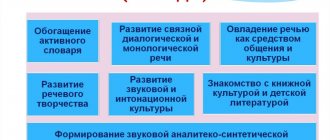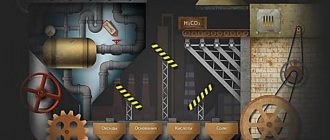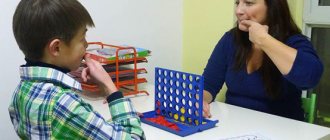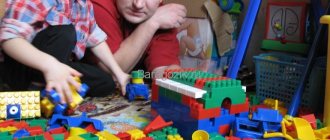Development of thinking in preschool children. How a person will grow up, what character qualities he will have, how active his thought process will be - is laid down in childhood. The preschool period is especially important. At this time, the body is undergoing intensive development, physical and mental, and the foundation of the individual is being laid.
Development of preschooler thinking
To find out how a child perceives the world around him, you need to know how a child, at a certain stage of life, comprehends the information received and systematizes it.
Understanding the age-related patterns of development of thought processes will make communication between a preschooler and an adult more enjoyable and productive.
As in any area of personality development, a child’s thinking goes through several stages and undergoes a number of changes. Parents need to know about the types of thinking that correspond to age characteristics.
Well-chosen games and joint activities have a positive impact on the formation of a child’s thinking and intellectual abilities.
How to develop thinking? Game requirements
First of all, let's talk about how to develop thinking in a child. Obviously, for this it is necessary to use the main type of his activity: of course, the game! It is this that will allow you to acquire, consolidate and develop new skills, and with them, thinking. It turns out that the main task is to make the game as useful, interesting and at the same time effective. Hence the main requirements for the game:
- it must have a thoughtful plot;
- the rules must be stated clearly, clearly and simply, in a way that is easy to understand;
- the child’s independent search for solutions should be at the forefront, and hints should be kept to a minimum;
- visibility is necessary: it is half the success. Vivid demonstration material will be easier to perceive, will endear you, attract attention and arouse interest.
Tasks that teach the identification of common features and classification are very useful for the development of children’s thinking. Offer your child bright, colorful cubes and construction kit parts (buttons as an option). Let your child separate them by size; by color; according to form. For older children, you can find and select furniture among the toys; dishes; animals; means of transport.
Types of thinking
Visual - effective
This type of thinking corresponds to the early period of a child’s life (from 1.5 to 2 years). This age stage is characterized by exploring the world around us with the help of our hands. The child disassembles, studies, and sometimes breaks toys in the process of exploration. This is how ideas about the world around are formed.
If the child’s active actions are aimed at studying the objects around him, we can talk about a visually effective way of thinking.
The task of adults at this stage is not to interfere with the baby’s desire to explore, to give him the opportunity to independently study the objects around him.
We must not forget that in the process of studying, a child is capable of breaking, damaging and even injuring himself. Parents need to encourage the desire to learn new things, but safety precautions must be taken.
Visually – figuratively
The next stage begins at 3-4 years and continues until 7 years. This does not mean that the previous one disappears completely. In addition to the existing skills of exploring the surrounding reality, the preschooler thinks using images. During this age period, an active ability to draw is manifested. All available materials are used: from pebbles on the street to mother’s lipsticks on new wallpaper.
When drawing an object, the young researcher imagines the image, its essential features that remain in memory, and tries to convey its characteristic features. At this stage, it is important to translate into reality the images that appear in his mind.
Creative
Determines the ability to be creative – to create creative, non-standard solutions. A preschooler is not able to develop his creative abilities on his own, so the emergence of creativity in him largely depends on the wishes of his parents.
Unlike previous types, the creative type does not depend on the age characteristics and intellectual abilities of the child.
An important condition for the emergence of creativity are such forms of mental activity as fantasy and imagination, which are characteristic of any child. It is necessary to create an environment in which the little man will feel comfortable developing his creative impulses. The types of creativity are varied: visual, musical, arts and crafts, choreographic. literary.
Adults must remember that there are no children incapable of creativity. Even those children who lag behind their peers in development are able to find unusual, creative solutions to problems, provided that this is facilitated by classes with parents and teachers.
Spatial
This type is the basis for further educational and, subsequently, work activity. Developing spatial thinking is necessary for correct orientation in space, the appearance of images in the mind, and the ability to use them in solving problems.
How to talk to a child correctly, communication rules for parents
Young researchers need to be helped to correctly perceive the shapes, sizes of objects, their location relative to each other, and their movement in space.
Boolean
Just like spatial thinking, it is the foundation for further full intellectual development.
If the baby has not mastered logical thinking, he will experience learning difficulties. As a result, not only the health of the restless person will suffer, but also the keen interest in understanding the world around him will disappear.
Read more about the development of logical thinking in preschoolers.
Engineering
This type of thinking introduces children to science, increases interest in the work of scientists and researchers, broadens their horizons through experimental activities, design, and creates the prerequisites for technical creativity.
Modern children receive most information from television screens, and not through their hands. Experiences and experiments teach you to think outside the box and find answers to complex questions.
Children's experimentation
Sometimes another type of child’s thinking is identified - child experimentation. It represents the unity of visual-effective and visual-figurative thinking, and is aimed at knowing the properties and connections of objects.
Such thinking takes the form of experimenting with a phenomenon: the child causes or stops the phenomenon, changes it in one direction or another. In the process of such actions, the child receives new, sometimes unexpected information, which often leads to a change in ideas about the object. For example, a child puts a wooden boat in a stream and sees how it floats, then he takes his toy boat made of iron and sees how it goes to the bottom. The child is perplexed, because both toys are boats that should float, but one drowned. Then the child comes to the conclusion that not every boat is capable of sailing and begins to investigate this issue. In this experimentation, the moment of self-development is clearly presented: the use and transformation of an object/phenomenon reveals its new properties to the child, which, in turn, allow them to make guesses and bring them to life.
Experimentation encourages a child's curiosity and initiative, independence, flexibility of thinking, courage, and stimulates the search for new solutions and creativity. Independent experimentation gives the child the opportunity to try different ways of doing things, while removing the fear of making a mistake (since there is no right option). The ability to be surprised by new things, to make your own guesses, to ask yourself and others questions is more important in the development of thinking than the reproduction of ready-made patterns of action and the assimilation of knowledge given by adults. The role of an adult in this process comes down to creating special objects and situations that stimulate cognitive activity and experimentation.
Formation of thinking of preschoolers
The development of thinking in a preschooler is determined by the ability to use universal mental operations inherent in thinking: attention, analysis, synthesis, comparison, classification, generalization.
Comparison
The baby learns to compare the essential and non-essential features of an object. It is necessary that he understands the importance of the process.
Analysis
This method allows you to break the object under study into parts and isolate its constituent components. For example, a child can easily name parts of a house: roof, chimney, window, door, etc.
Synthesis
The opposite of analysis is a mental operation, that is, in the process of synthesis, the preschooler combines individual elements into a whole. An example would be the skill of coherent reading.
Generalization
Typical for a preschooler aged 6 years. Appears as vocabulary accumulates and generalized concepts are used in speech.
Learning English letters with children quickly and easily, useful tasks
Classification
A mental operation that allows you to find similar and distinctive features of certain objects, concepts and phenomena.
Mental operations
Observing how a child’s thinking develops, the entire thought process can be divided into stages:
- comparison;
- analysis;
- synthesis;
- generalization.
At the comparison stage, the child learns to find the same in different things, different in the same. During this period, it is appropriate to give “find the differences” pictures and play memory games (start with 6 pairs of pictures, gradually increasing the number).
At the analysis stage, features, qualities, properties, materials and objects used are identified. In his imagination, a child can divide any product into its component parts.
The synthesis stage is closely related to the analysis stage. Without analysis it will not be possible to synthesize. An example of this is reading. Without remembering letters, without understanding how they merge into syllables, a child will not be able to read.
Vivid signs of generalization are the identification of common characteristics of objects and grouping. As soon as a child develops coherent speech and the use of a large number of generalizing concepts, you know that the generalization stage has begun.
Methods for developing thinking in preschool children
For a child to be successful in school, timely, systematic preparation is important. If the child attends a preschool institution, the educational program of the kindergarten includes work on the development of thinking.
However, parents are able to make communication with their child productive and interesting by using small developmental tasks.
"Find the odd one out." Find the odd one among the suggested words and explain the solution. (Training generalization)
- Kilogram, hour, second.
- Notebook, glass, spoon.
- Pan, backpack, bag.
"Look for a mate." (Training analysis, comparison)
Children's lotto is used with pairs of similar cards. One child (the leader) takes the card and, without opening it to the others, tells what he sees on it. Others look at their cards and find an object on the card that is similar in description. If the description matches the answer, a couple of cards are removed from the game and the game continues.
Memory and attention are important mental processes that affect the intellectual development of a fidget. Therefore, when developing thinking, it is necessary to use tasks to develop attention and memory.
alt: Example of developing lotto “Fruits”
“One sign for all” (we develop thinking, speech, passive and active vocabulary, attention)
You need to name as many objects as possible that have this characteristic (for example, high). To do this, you need to answer the clarifying question: “What is tall?” (mountain, tree, closet, building, etc.)
“What’s missing” (training your memory)
The lesson does not require any special preparation. Objects in front of the child are covered with an opaque cloth, and one or more toys are hidden. Then the fabric is removed. The preschooler's task is to determine what has disappeared.

